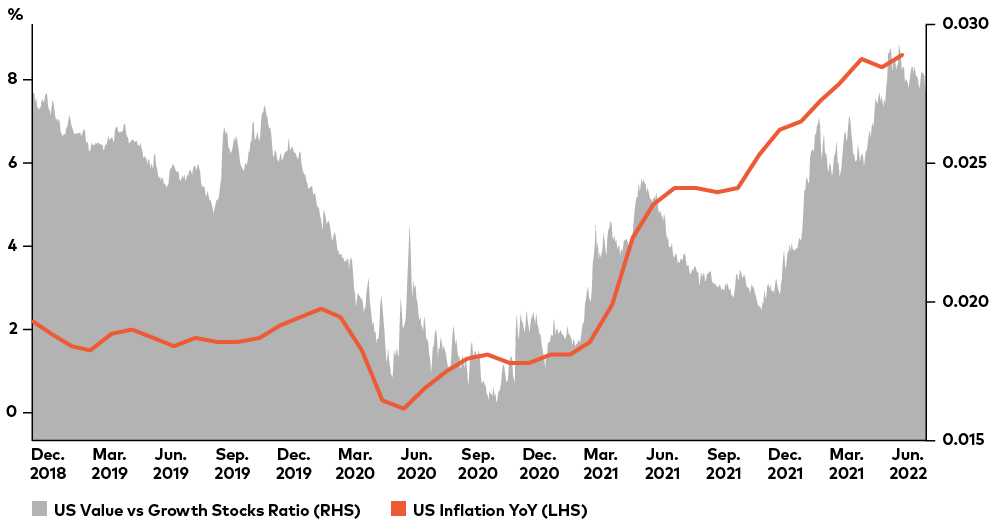by Andy Kochar, Vice-President, Portfolio Manager and Head of Global Credit, AGF Investments LLC
It may be too early to say we have officially entered the post-pandemic phase in markets, but the re-opening of the global economy over the past year has no doubt changed the dynamic for investors. In no way, perhaps, is this more evident than in the return of value investing in recent months. In fact, thanks to unprecedented levels of fiscal and monetary stimulus since early 2020, many investors – in the subsequent face of higher inflation (and inflation volatility) – are asking themselves two questions critical to the notion of value investing that they may not have asked in a very long time: What is my investment worth and is the price to own it more or less than its true value?
Value Versus Growth Ratio and Its Relationship With Inflation (Year-Over-Year)

Source: Bloomberg LP, as of July 7, 2022
Of course, most investors will be familiar with value as an equity strategy, but perhaps fewer understand how important it can be to achieving successful credit exposures. Moreover, value is not just important, but intrinsic, to credit investing. And if you have not considered value investing in the context of credit before, there may be no better time than right now. As the legendary credit investor Howard Marks says, “there’s only one form of intelligent investing, and that’s figuring out what something’s worth and buying it for that price or less.”
Let’s explore how and why that is the case. First, value investing in any market has a couple common key elements. At its core, a value investor looks to purchase companies at prices that are at or lower than their intrinsic value. Moreover, they seek out opportunities in companies whose valuation may provide a high margin of safety, in the sense that the price is low enough to limit downside risk. And the difference between price and value needs to be significant enough to provide both that margin of safety and the potential for return on investment.
For value investors, quantifying an asset’s margin of safety requires a view on the implied risk premium built into corporate valuations – in essence, we are compelled to ask the question, is it worth taking the extra unit of risk for the incremental expected return. In the equity world, investors use such familiar measurements of a stock’s “cheapness” either by applying outright metrics such as equity risk premium (adjusted for beta) or relative valuation measures such as price-to-earnings and price-to-book. In the world of credit, quantifying “cheapness” involves more nuanced metrics. When looking for bargains in corporate bonds, value investors look at an asset’s implied credit risk premium, an umbrella term that is really a function of several factors. Those include:
- Implied default risk – the likelihood a borrower will not be able to pay back its debt.
- Downgrade risk – the probability of a decline in the borrower’s creditworthiness.
- Recovery rate – the proportion of debt that investors can expect to be repaid in the event of default.
- Liquidity risk – the chance, basically, that you won’t be able to sell a bond as quickly as you might want to, or at all. Often what we may perceive as credit risk may simply be compensation for illiquidity. This is an important feature pervasive in private markets.
Is now the time for a value approach in credit? The answer is yes, although hesitantly so because credit investors are always looking for value – in good times and bad, in bull markets and bears – by making an informed assessment of risk. Yet the current market environment, which has been a significant source of heartache across asset classes, at the very least provides an opportunity for all investors to consider the merits of value strategies over the long term.
After all, as bad as things have been this year in markets – including credit markets, the sharp decline in prices has at least opened the door to investment opportunities where companies with attractive long- term fundamentals are potentially being unfairly punished by fearful investors. If so, their bond prices may be trading far below their intrinsic value, in a range that might adequately compensate value investors for taking on the implied credit risk. For instance, the selloff in technology and healthcare equities this year has been replicated in bond markets, and credit spreads (the difference between the interest-rate premium for corporate bonds over government benchmark bonds) in these sectors have widened, making them look like potential value opportunities. But unlike stocks, bonds possess a finite life (their maturity date) and depending on when you buy them they will be pulled to closer to par resulting in attractive total returns. As credit investors, then, it’s safe to say that there is finally value in the growth-oriented sectors of the market.
One could argue that markets today are transitioning (painfully) out of a long period during which the relationship between price and value was irrational, as Marks might put it. In the Marks-ian view, risk is less about volatility than about the probability of losing your investment. During bubbles, markets tend to act as if that probability is negligible, and prices often exceed value; during bear periods, markets tend to act as if that probability is a near-certainty, and drive prices below value. These are moments when value investors look for opportunities. After all, as Marks wrote in his 2011 book, The Most Important Thing, “trees don’t grow to the sky, and things rarely go to zero.”
Andy Kochar is a Portfolio Manager and Head of Global Credit at AGF Investments LLC. He is a regular contributor to AGF Perspectives.
To learn more about our fundamental capabilities, please click here.
To learn more about our fundamental capabilities, please click here.
The views expressed in this blog are those of the authors and do not necessarily represent the opinions of AGF, its subsidiaries or any of its affiliated companies, funds, or investment strategies.
The commentaries contained herein are provided as a general source of information based on information available as of July 7, 2022 and are not intended to be comprehensive investment advice applicable to the circumstances of the individual. Every effort has been made to ensure accuracy in these commentaries at the time of publication, however, accuracy cannot be guaranteed. Market conditions may change and AGF Investments accepts no responsibility for individual investment decisions arising from the use or reliance on the information contained here.
“Bloomberg®” is a service mark of Bloomberg Finance L.P. and its affiliates, including Bloomberg Index Services Limited (“BISL”) (collectively, “Bloomberg”) and has been licensed for use for certain purposes by AGF Management Limited and its subsidiaries. Bloomberg is not affiliated with AGF Management Limited or its subsidiaries, and Bloomberg does not approve, endorse, review or recommend any products of AGF Management Limited or its subsidiaries. Bloomberg does not guarantee the timeliness, accurateness, or completeness, of any data or information relating to any products of AGF Management Limited or its subsidiaries.
AGF Investments is a group of wholly owned subsidiaries of AGF Management Limited, a Canadian reporting issuer. The subsidiaries included in AGF Investments are AGF Investments Inc. (AGFI), AGF Investments America Inc. (AGFA), AGF Investments LLC (AGFUS) and AGF International Advisors Company Limited (AGFIA). AGFA and AGFUS are registered advisors in the U.S. AGFI is registered as a portfolio manager across Canadian securities commissions. AGFIA is regulated by the Central Bank of Ireland and registered with the Australian Securities & Investments Commission. The subsidiaries that form AGF Investments manage a variety of mandates comprised of equity, fixed income and balanced assets.
® The “AGF” logo is a registered trademark of AGF Management Limited and used under licence.
Copyright © AGF Investments LLC















